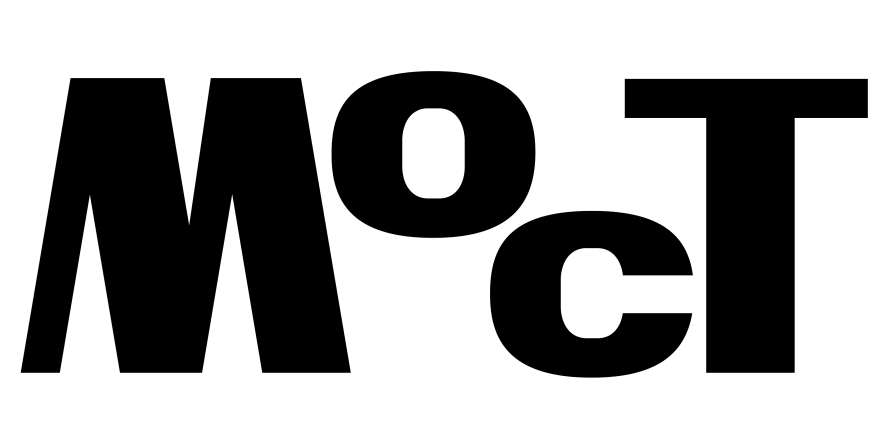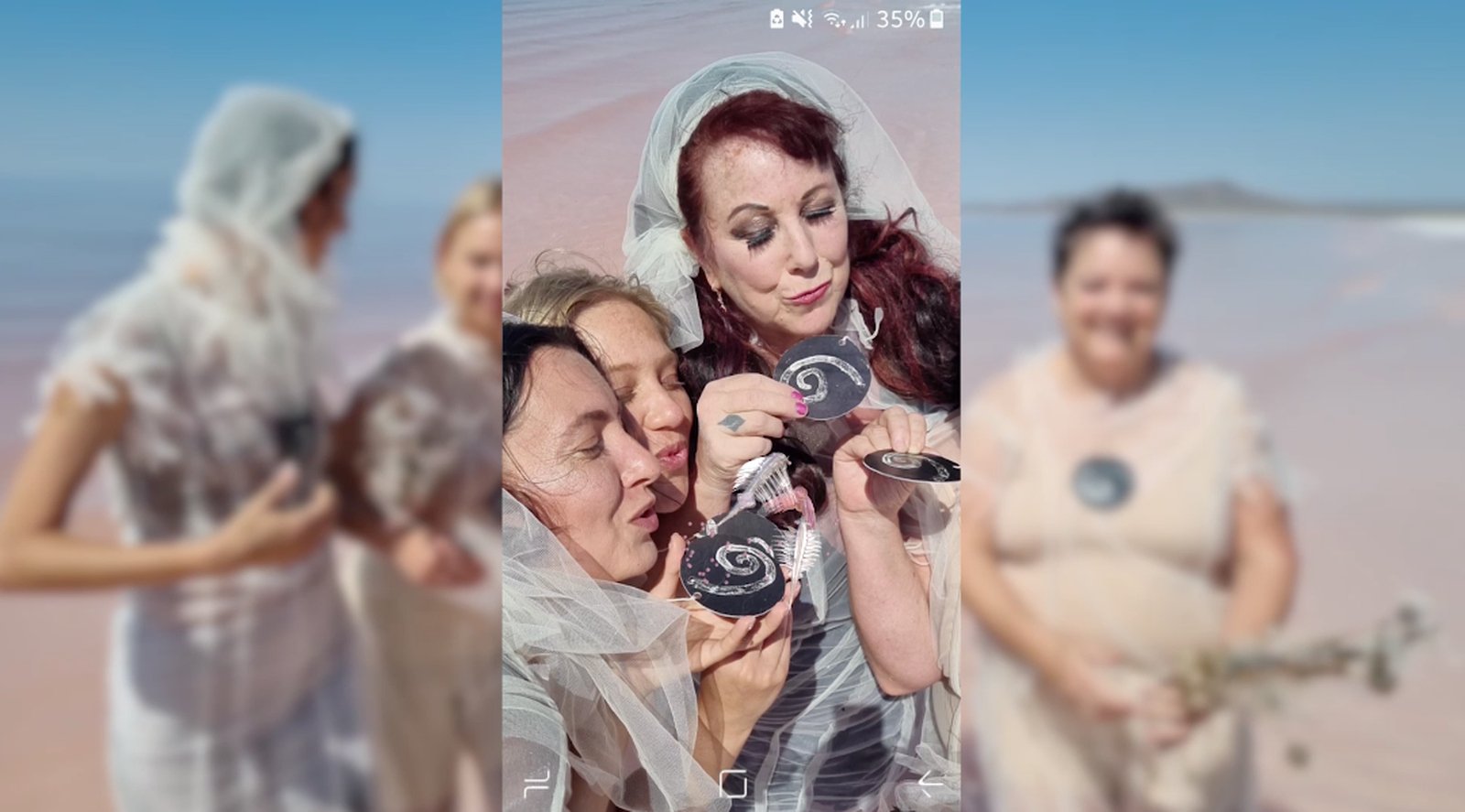Conducted by Katie Zazenski
We sat in conversation and continued some of the exchange via email, on the occasion of the exhibition SPLASH: eco + hydrosexuals unite! at Lokal_30 in Warsaw. The exhibition, on view from 15.06. – 14.09.2024, features works by Annie Sprinkle and Beth Stephens, and cyber_nymphs duo Ewelina Jarosz and Justyna Górowska, as well as collective projects of the four. We were joined as well by director, coordinator, friend, and collaborator of Annie and Beth, Joy Brooke Fairfield.
Katie Zazenski: How did the four of you (Annie, Beth, Ewelina, and Justyna) meet?
Ewelina Jarosz: In 2018 I was collaborating with my then-partner Zofia nierodzińska, who curated the first exhibition of Annie and Beth’s works in Poland. The exhibition title was The Romantic Adventures of Beth Stephens, Annie Sprinkle and Breast Cancer, and featured works from their series Cancer Erotica. The show was held at the Municipal Gallery Arsenał in Poznan. I wrote a review, and that’s how I met Annie and Beth, through Zofia! I was then granted a Kosciuszko Foundation scholarship to work in the US, to reimagine Robert Smithson’s Spiral Jetty and explore the possibilities of “ecosexuality”, a concept that helped me to channel current climate change issues through land art and environmental art. I decided I would like to collaborate with Annie and Beth for this. I also invited Justyna for this collaboration, to share her visions and talents, and become the artistic and conceptual director of the project. She joined me, Annie, Beth, and Joy in Utah; Joy influenced the reimagining of this land art piece by introducing a land acknowledgment. Justyna and I shared and exchanged skills, and then decided to work as a duo! And we became cyber_nymphs.
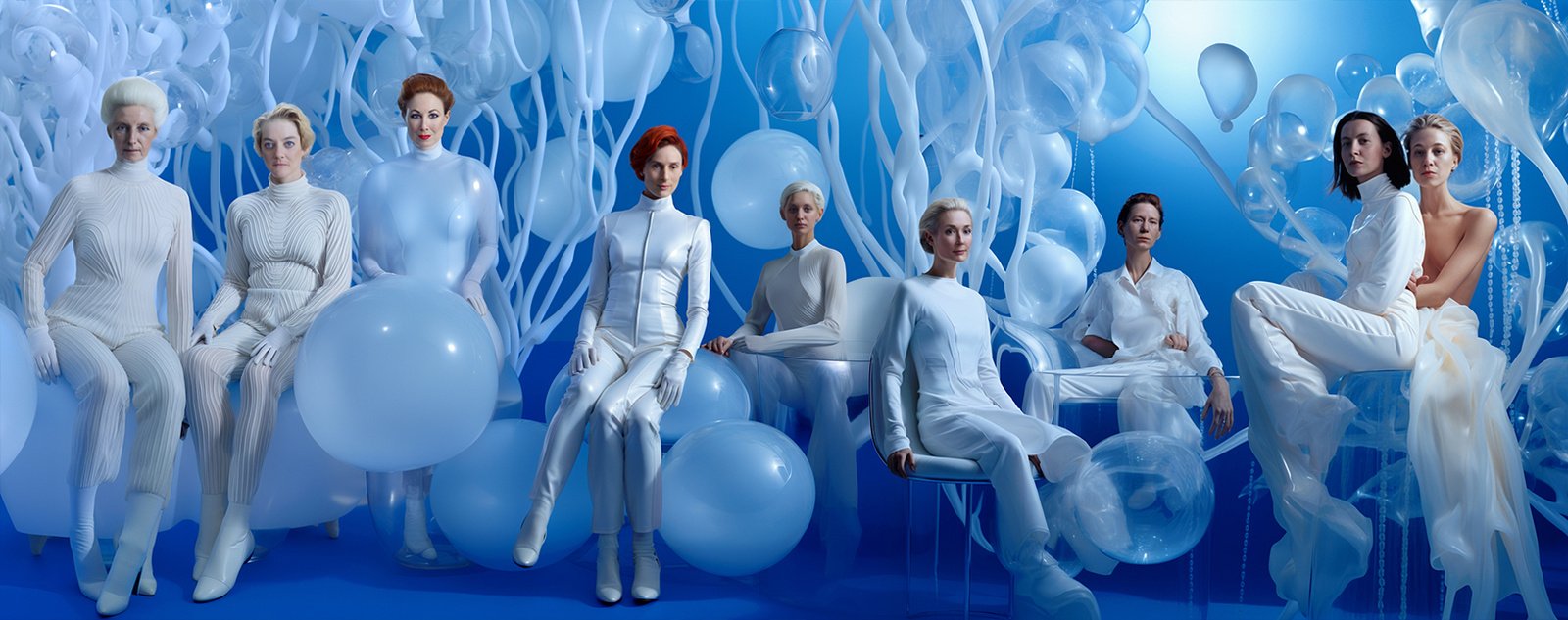
KZ: And Joy, how did you enter into this community?
Joy Brooke Fairfield: I met Annie and Beth 11 years ago in San Francisco; I was doing my PhD at Stanford and I was stage managing and doing tech for one of the last big shows they did inside a theater. In the last week of rehearsals, their director had to drop out, and I was like, oh, I can do it! And we just fit together really well. I love working with them. I’ve had the great opportunity to travel with them for projects over the past ten years, as I’ve been doing my academic career alongside it. We got introduced because I was writing about them in my dissertation, so I went from studying them as a subject and, you know, perusing their Love Art Laboratory website, thinking “gosh, this is so cool,” to working with them, which is even more pleasurable!
Annie Sprinkle: Joy has been a huge miracle for us. She is so talented and helps us to keep our shit together! She’s simply a fantastic director and collaborator in every way.
KZ: Annie and Beth, I would like to ask about the notion of pleasure in terms of your public performance work. Public pleasure, specifically for female or female-presenting bodies – is something that is so often made shameful for these bodies. As well, it is more often than not sexualized through the male (patriarchal) gaze, how do you subvert this?
AS: Porn star Nina Hartley said it best. “The problem isn’t being sexually objectified, it’s that some men need to learn better manners.” Most of our performance work is outdoors in public space, and men in public are usually kind of afraid of us – or intimidated by us – because we are pretty shameless. Being outside is important as we feel the sun and the fresh air, and can be around trees, and feel part of the natural world, and we can enjoy the magnificence of our ecosystem. We can get away from our computers and kitchens and bedrooms. We like to imagine the Earth as all genders, so we like to include all genders in our work. That includes men! We also love to include and always aim to include sex workers, as they are generally more sex and body positive, and are in general have less shame about their bodies, nudity, and flaunting some sexuality. As ecosexuals, some of us dress pretty slutty for public space. We revere drag queens, trans women, and their bodies. So we always aim to cast trans and gender queer performers.
A few days ago when we did our Ecosex Walking Ritual in Düsseldorf. And some parts became a live ecosex show! Three of our performers put butt plugs with grass seeds dangling from strings into each other. It was wild and shameless and also about the environment. We aim to make environmental art and activism a little more sexy, fun, and diverse. We aim to seduce our audiences into being more appreciative of the non-human realms. Our bodies are in fact part of the Earth! All sex is ecosex!
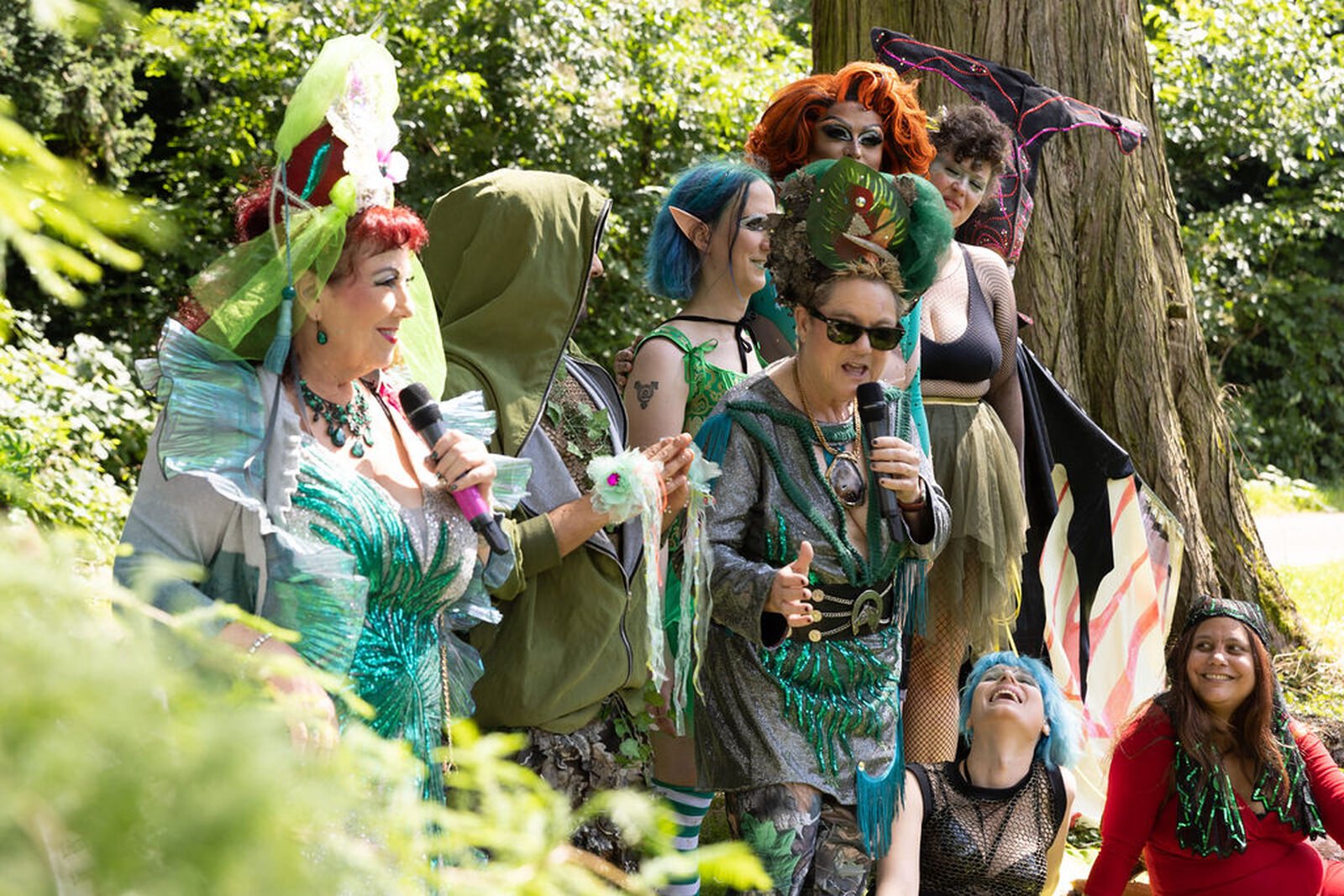
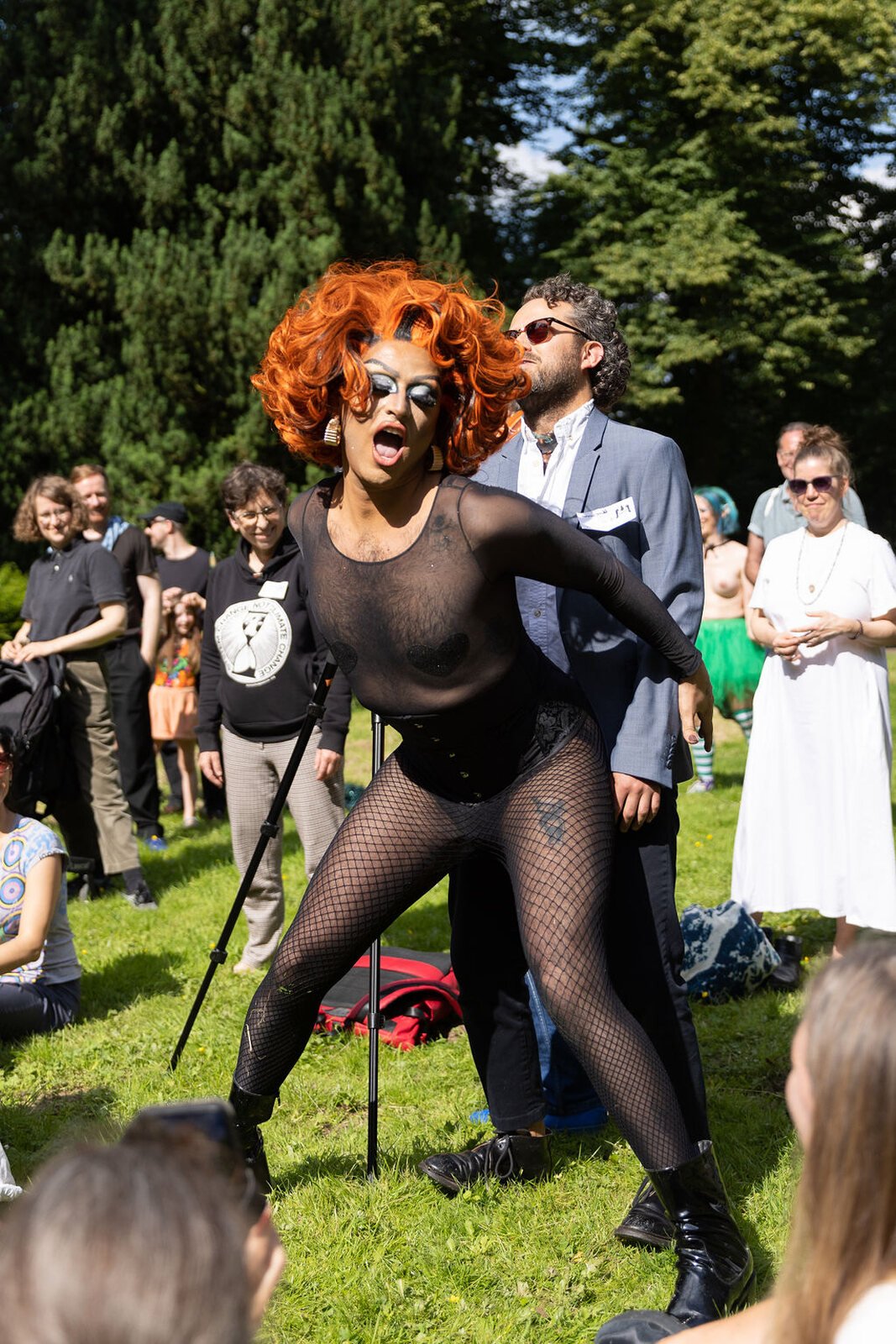
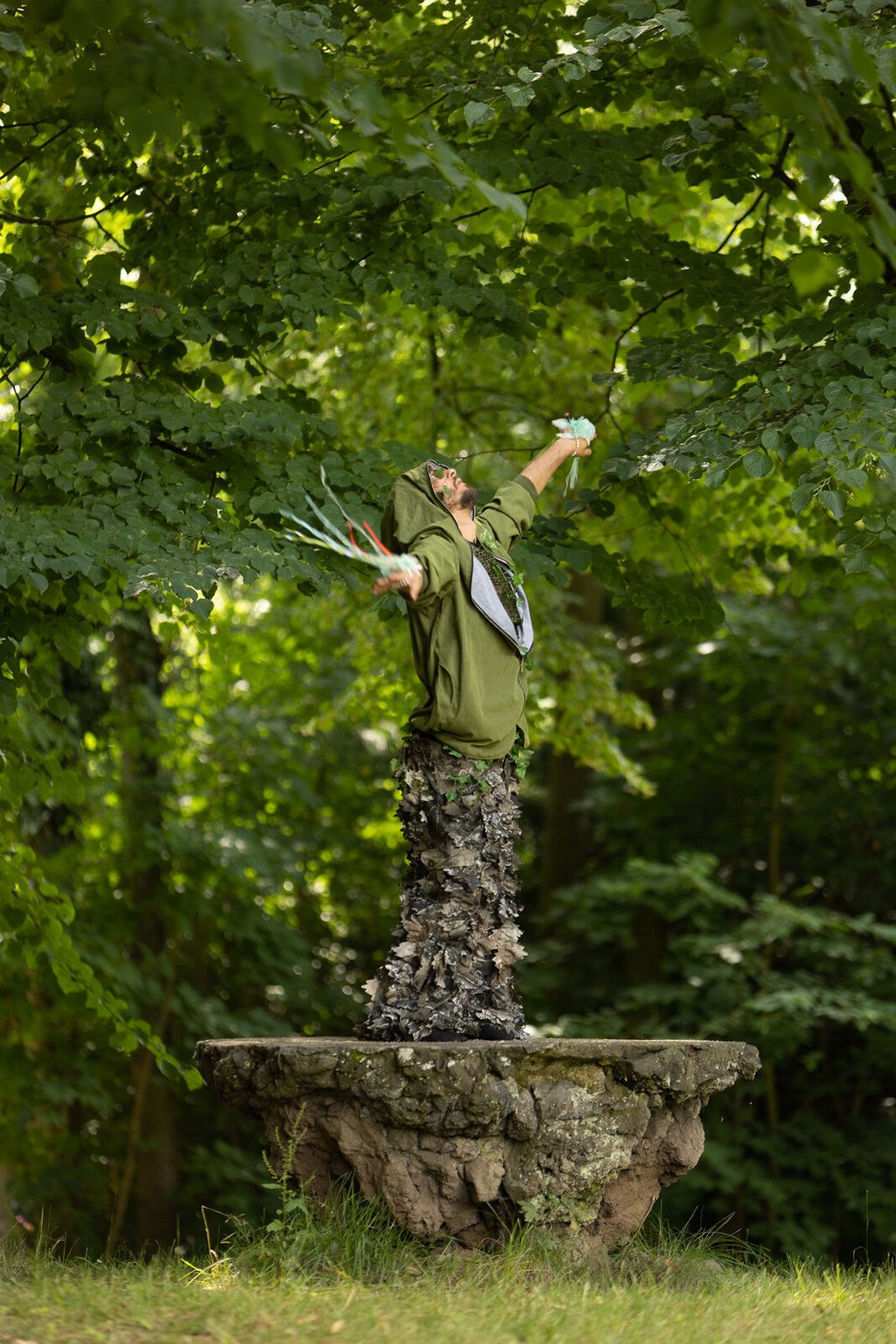
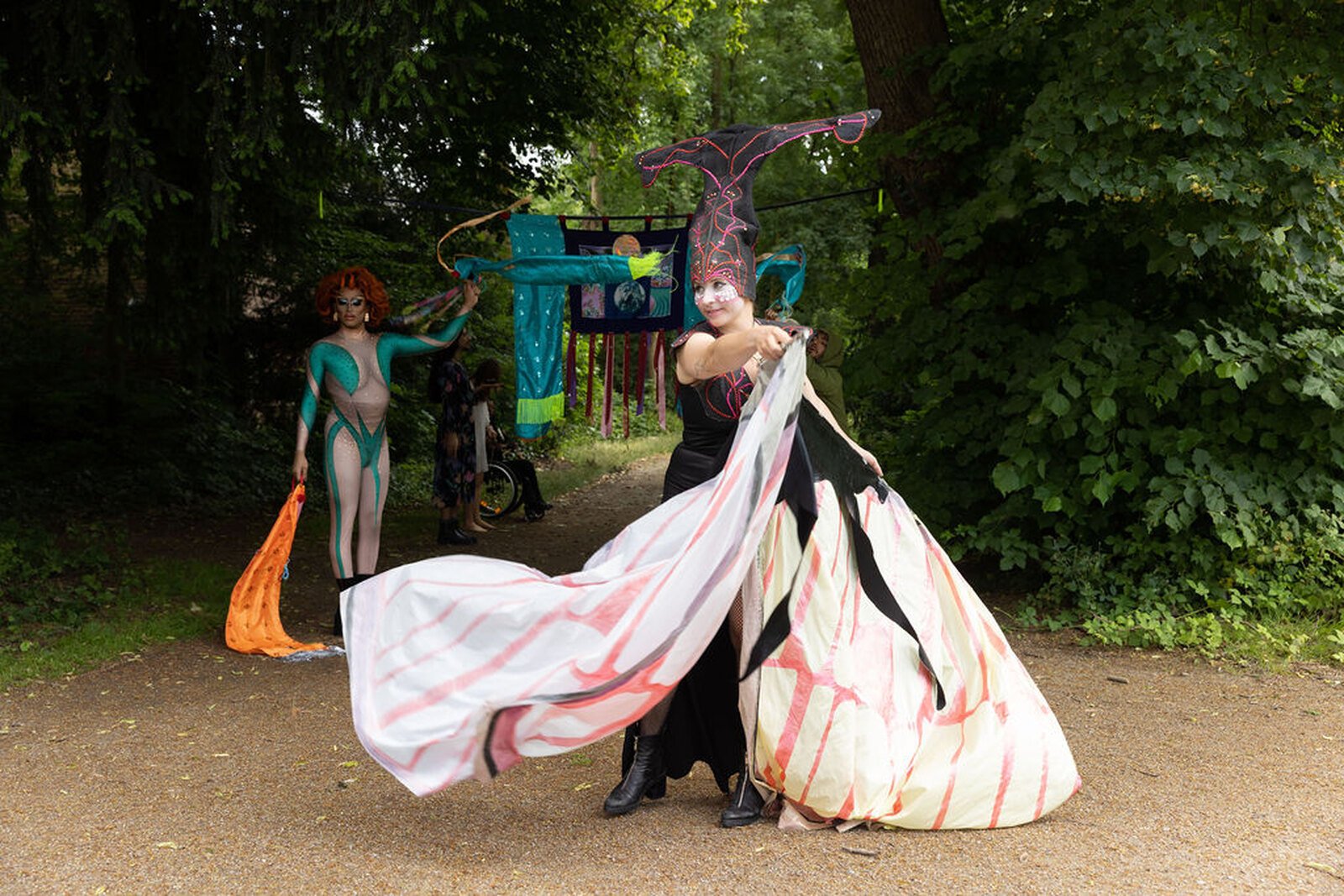
Beth Stephens: I don’t know if we subvert the male gaze as much as add to the ecologies of “the gaze.” I think all groups gaze differently, and that is what makes each of our experiences unique and beautiful as well as powerful. The “male gaze” is old news, even as it re-exerts its power in this moment of conservative backlash. Between now and when Laura Mulvey wrote her famous article in the 90’s, Visual Pleasure and Narrative Cinema, there has been a lot of discussion of the “gaze.” So Annie and I have appropriated that term for the ecosexual movement to empower our “ecosexual gaze,” which is an important part of our movement.
Actually, when I was a graduate student studying art at Rutgers University, I asked Annie to model with me on my Harley Davidson motorcycle, for a photo project about the lesbian gaze for my exhibition, Who’s Zoomin’ Who? in 1992. One image from that shoot was included in the Lokal_30 exhibition in Warsaw. So our work now is an extension of that project, plus we both believe in and practice pleasure activism. We love public displays of pleasure, especially by women, non binary folks and queers. These actions both provoke and normalize our activities. For instance, in our most recent piece in Düsseldorf, the one that Annie just mentioned, we created a magic portal, which was a tapestry that we hung between two trees to create an entry-way into a magical ecosexual space. We invited our audience to walk through it and awaken their senses. We invited our participants to assume the Ecosexual gaze, and it is this gaze that allows us ecosexuals to connect nature entities with eyes, ears, nose, taste… And since we are doing this in public space, it addresses your question of public pleasure, as our walking tours and rituals are outside and in public. While we have been attacked verbally, and once we had a beer bottle thrown at us, in general, our public performances invite curiosity from people who are not participating in our performances. For our participants, the ecosexual gaze practiced within the performances frees them to imagine the Earth as their Lover. For many people, this is a way to shed shame, to begin seeing and feeling beyond the binary systems we are all taught, and to understand that humans and nature are not separate but are one system within a huge ecosystem. It is beautiful to feel one with the Earth, and it subverts the patriarchal gaze, which is more about individuality, ownership, division, and mastery over, into something that is way more collective and reciprocal.
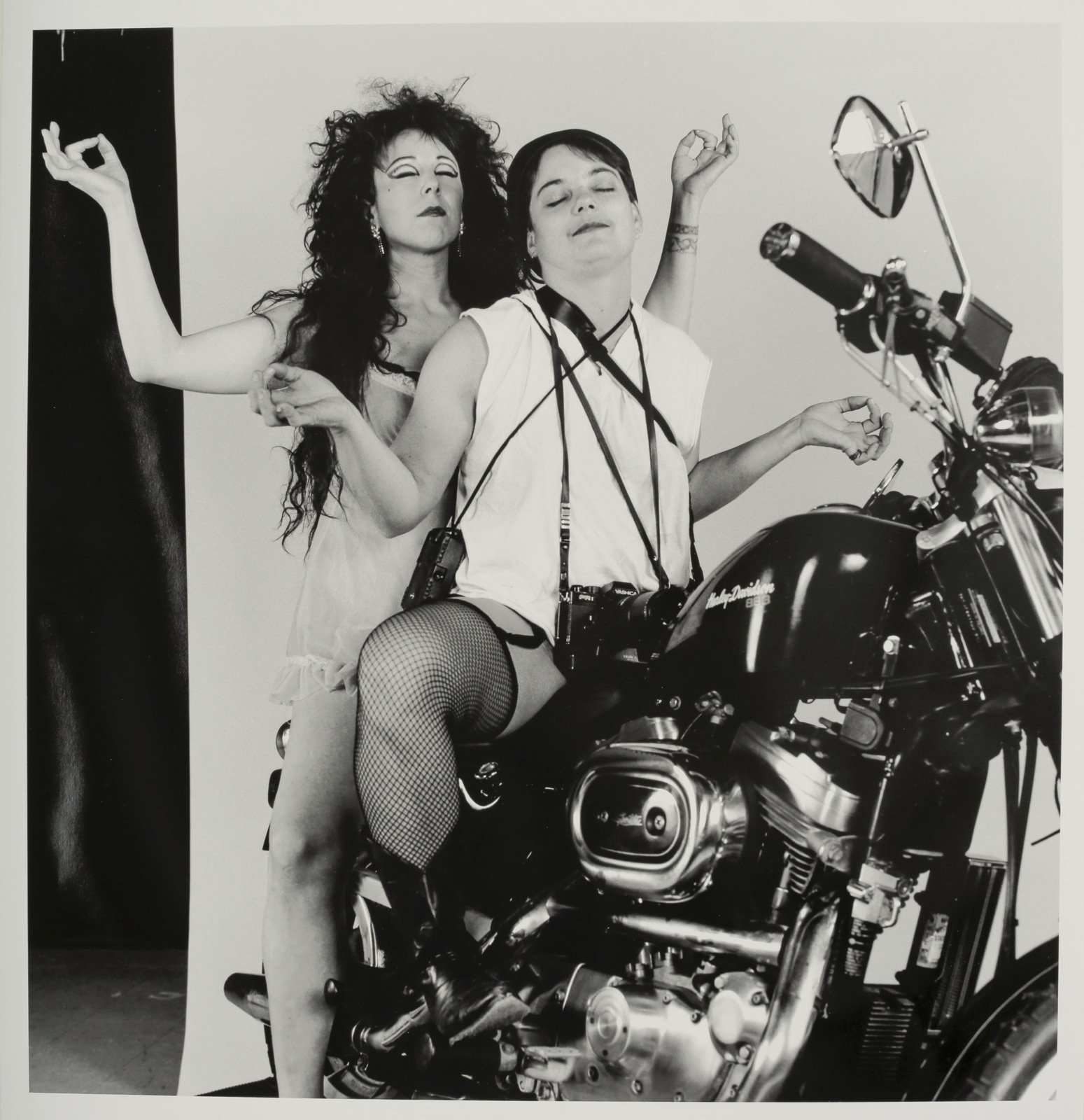
KZ: Joy, do you have some insights into how people respond to Annie and Beth’s work in different communities?
JBF: I direct Annie and Beth’s site-specific performance work, which is what we call social practice, or socially-engaged art. So the most important part is the process with the community that we’re going into. We’re way more process oriented than product oriented, and we kind of love the creative, beautiful, improvisatory chaos that can come from real engagement with artists and the place that we’re going to, the natural environment as well as the cultures and subcultures we’re interacting with. My job is to help facilitate that.
I think abroad, sometimes people come to see Annie and Beth because they’re notorious. Obviously some queer people and trans people and ecosex-oriented people come because they’re fans, which is amazing. But sometimes people come because they think it might be dirty or dangerous. And I think those people are often surprised to kind of fall in love with the approachability and humor and down to earth-ness of Annie and Beth. They’re just sweet, nice, funny, humans. So I love watching that kind of thing happen. Also sometimes people think it will be very snooty and highbrow and conceptual, and then find it’s a little more folk and connective than they’d assumed.
KZ: And maybe this – the balance between the folk and the scientific/technological – is what makes this collaboration between Annie and Beth and the cyber_nymphs so strong. Ewelina, Justyna, can you talk about how you use and navigate the materiality of technology in your work, especially in the context of eco- and hydrofeminism?
EJ: Technology is an integral part of our lives. We cannot remove it, whether we want to or not. The question is, how can we use technology for the benefit of the planet? As cyber_nymphs we delve into the concept of eco-technology, as explored by Professor Cecilia Åsberg who directs The Posthumanities Hub – a multi-reseach platform bringing closer together feminist STS (science and technology studies) with all sorts of critical posthumanities – at Linköping University. Åsberg, who hosted me as a researcher last year, dedicated years of her research to building bridges between science and the new humanities within a feminist framework. Following these ideas, as the cyber_nymphs, we are researching the environmental costs associated with creating digital art.
Justyna Górowska: We want to explore the alternative to the dominant cycle of distribution of knowledge and power. Technology is often developed primarily within military contexts, and these innovations eventually transition into commercial applications. I approach recent advancements in technology from an artist’s perspective, exploring them within the realms of aesthetics, and the social and environmental practices of avant-garde art. I am familiar with technology and enjoy working with it. I also feel deeply connected to cyberfeminism. I believe that, especially now, when technology is causing considerable harm – such as the impact of social media on our minds – we need to reclaim these tools and use them ethically. By doing so, we can address more important issues, make a positive impact on the world, and foster hope for the future.
EJ: It is crucial to place these ideas within the context of queer and feminist theory and practice, reframing and redesigning them accordingly. For instance, to consider how artificial intelligence can be reimagined in the context of care and support. Technology offers possibilities! Justyna’s skills enable us to explore these innovative and unconventional ideas.
JG: I love working with technology because it feels like a magical wand that grants you a unique kind of power. Our current projects involve exploring augmented reality, virtual reality, and delve into artificial intelligence. Recently, I even trained an AI to become my alter ego, wetmewild. Just last week I performed a conversation with this AI persona, or avatar, as a form of artistic expression. We’ve been experimenting with training her as a Slavic water nymph (@wetmewild) who engages in interactions about the pollution of the river she inhabits, as well as other critical issues related to the water crisis we are facing.
EJ: Another supportive system for Justyna! And she (the AI persona) says, “Oh, my sweet creator.”
KZ: Wow, that’s a little terrifying!
JG: Yes! So we are trying to re-train the avatar so that the supportive narrative becomes “’dear collaborator.”
KZ: Annie and Beth talk about reframing the idea of “Mother Earth” to “Lover Earth” because of the shift in the power dynamic when we go from mother to lover, right? A mother’s love is so often an unequal love, a love that’s almost impossible to be fully reciprocated. So it’s somehow a related reframing here, going from a subservient position to one of equal power, to collaborator, right?
EJ+JG: Yes!
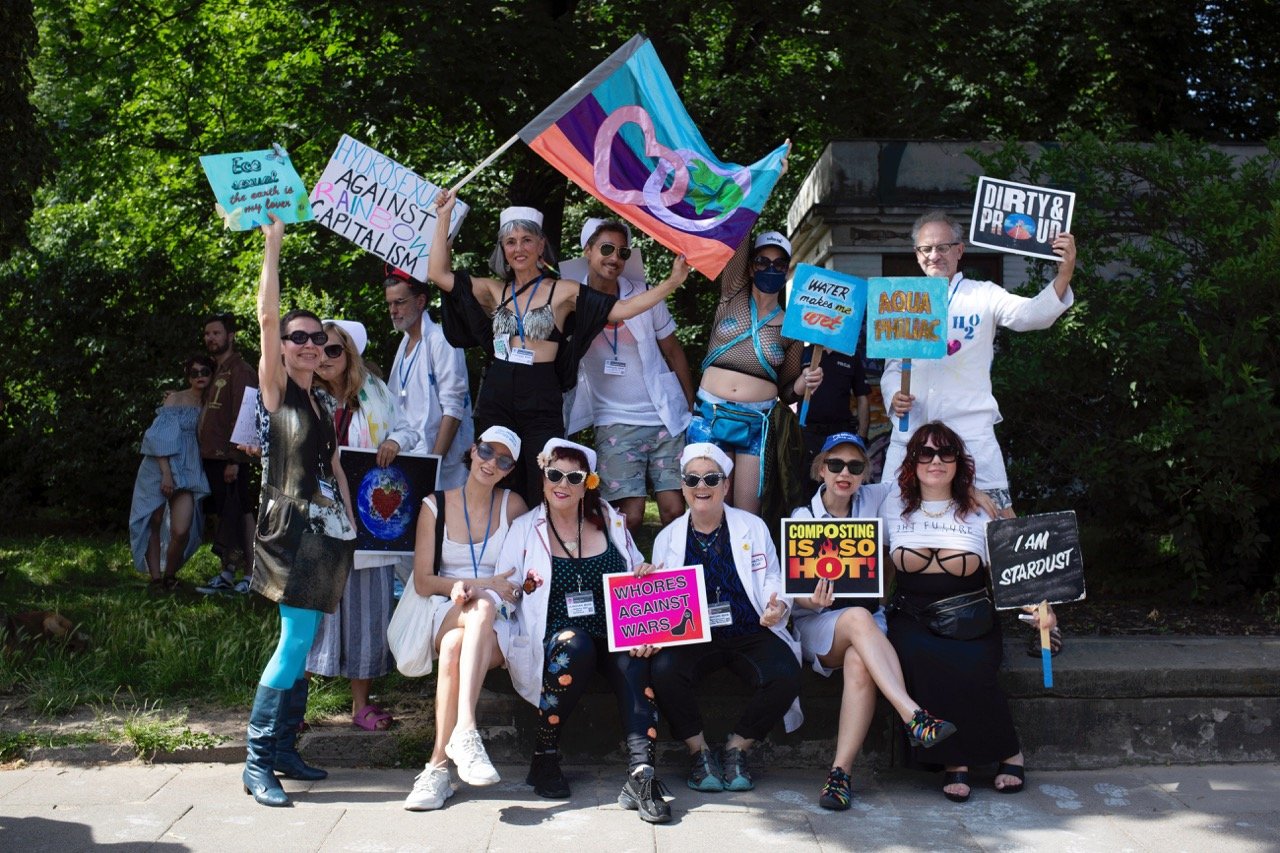
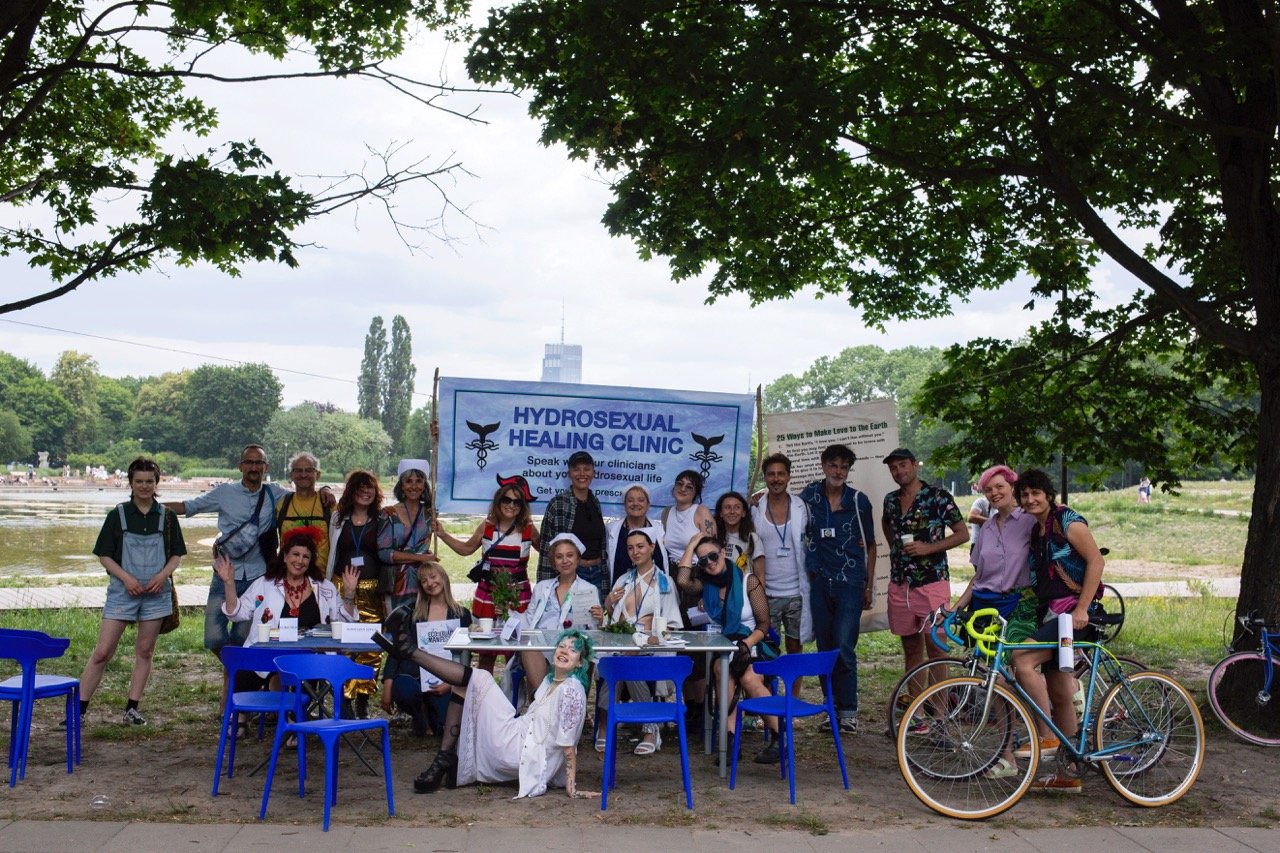
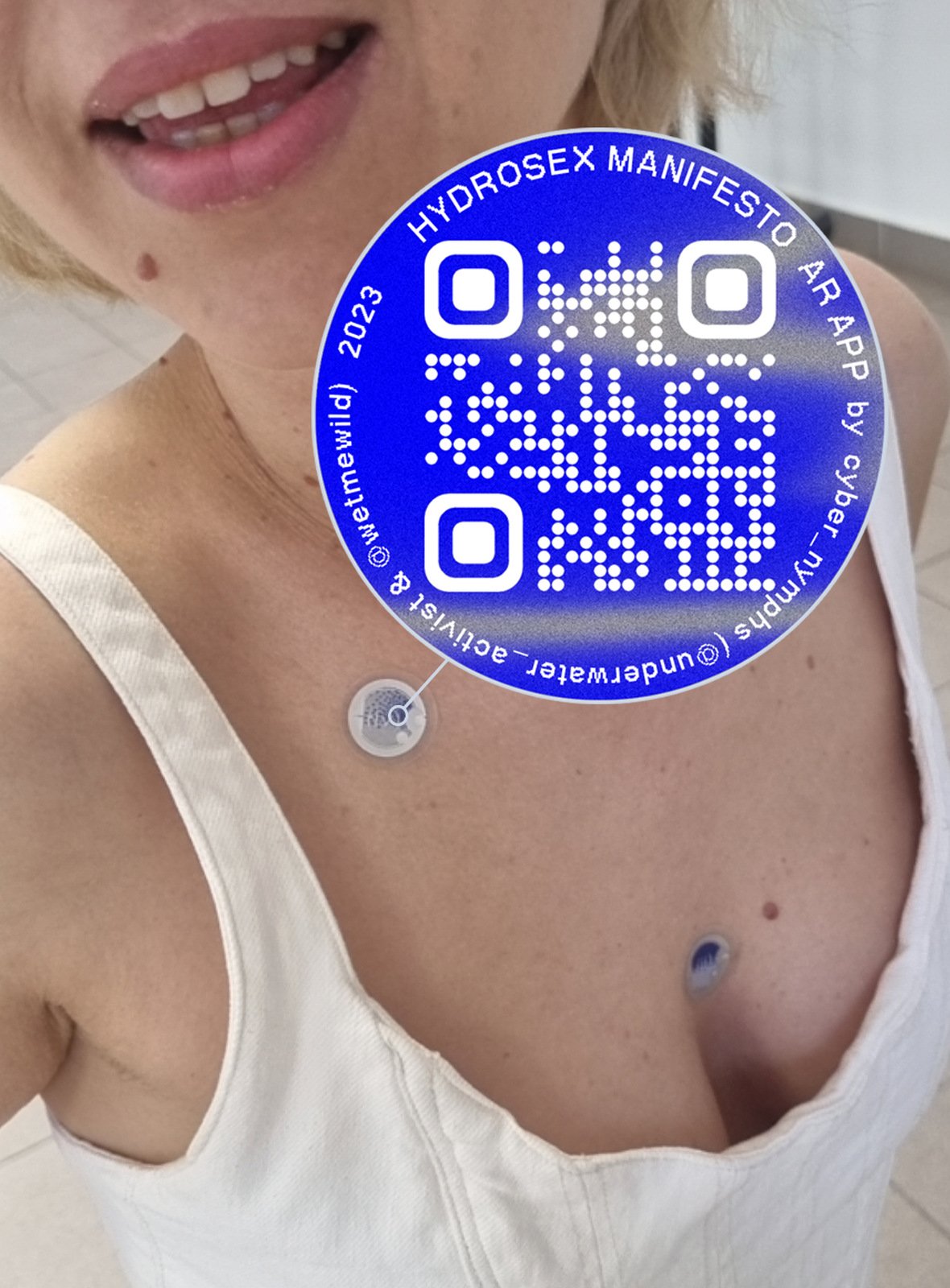
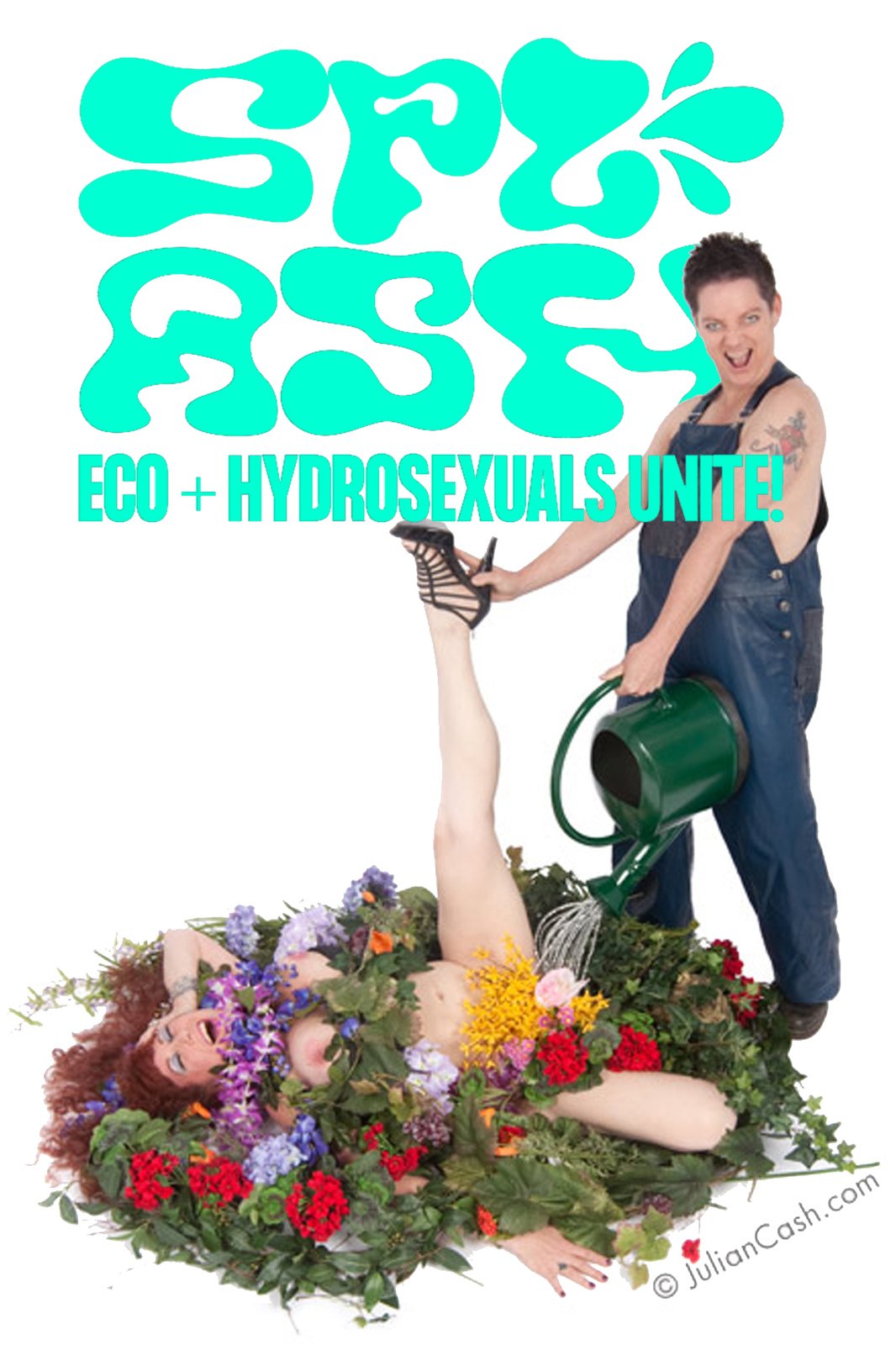
KZ: I would like to ask you about another element that is very present in your work, in Annie and Beth’s work, and your work together as hydrosexuals: fluids. Our bodies are, what, 70% water? We are fluid beings. The Earth as well is majority water. But fluids, specifically bodily, especially in contemporary Western culture, are taboo. As well as the idea of being fluid – like if you’re not squarely positioned in the gender binary, or even professionally – if you’re between occupations or disciplines, it tends to represent indecision or weakness, in capitalist society. So what do you think about fluids and how do you think about fluidity?
JG: For me, long before we even met, Abject Art was a great inspiration. The Theory of Abjection, by Julia Kristeva, deals with bodily fluids that we reject, that we’re not happy with – how can we think about them as extensions of our bodies? The abject is something that connects us to the animal world, you know? So I see fluids as something that unites everyone. I find this fascinating, especially in the case of the female body and its oppression. I also think that humidity connects so much with our erotica and sexuality, so it’s something that I really love to dig out and talk about. By “humidity” I mean the natural moisture and fluidity associated with the body, which often carries a sense of intimacy. It encompasses sexual fluids, highlighting our most primal and raw experiences.
EJ: We also draw inspiration from other brilliant theorists like Stacy Alaimo or Astrida Neimanis. The latter, for instance, explores the figuration of “bodies of water.” She begins with the biological fact that up to 90% of our bodies consist of water – through sweating, kissing, urinating, menstruating, and more. For Neimanis, this serves as a starting point for humans to transcend their individuality and to stop thinking about the human body as an autonomous entity. Considering the toxicity and microplastics we are infused with – the topics explored by Alaimo – the concept of “bodies of water” helps the cyber_nymphs to better relate to environmental issues and the climate crisis.
JG: Neimanis also refers to the term hypersea, that maybe we’re all separate containers of water; but on a bigger scale, we are creating one big pond or ocean or body of water which is circulating and connecting all bodies of water – human and non-human, which is a beautiful metaphor!
EJ: I would say that through the new humanities and the arts, more and more pathways are opening for humans to address post-identity, or non(identity), emphasizing the need, desire, or even the necessity to disassociate from anthropocentrism, essentialism, speciesism, and other limiting ways of defining who we are. I’m a queer lesbian, but I am also the Baltic Sea that I breathe or even the cloud I chase, which has transformed from a river drop. The concept of “ecosexuality” also serves well to connect us to a larger planetary sense of belonging. We can practice it by trying to find out what kind of kinship we can forge with other species, especially as we face the Sixth Mass Extinction caused by our species. At our exhibition, you may also find the hashtag #genderfluid, something for those of you who conceive gender as a prison. We aim to connect all these ideas that arise from art, such as ecosexuality or hydrosexuality, with perspectives provided by amazing new feminist scholars developing blue humanities, environmental humanities, and queer studies. It’s a holistic approach.
KZ: But actually as we’re talking about this, I’m also thinking about your name, cyber_nymphs, which connects the ideas of computers and technology with mythological water beings. But fundamentally, fluids (water) and digital (electronics) cannot coexist. Right? Fluid fries technology, makes it rust and erode.
JG: But they cool servers under the water! Water is still close to technology!
JBF: They can coexist with good boundaries!
KZ: Ha, yes, good point! Joy, how about the work of the cyber_nymphs outside of Europe, can you talk about your experience of observing/participating in their work abroad?
JBF: This is a great question for me because as the director, I love standing in the back and watching what’s happening between the audience and the performers. In June of 2023, we held a symposium called EcoSex and the City at Performance Space New York, a legendary venue in the East Village. The cyber_nymphs performed in our main evening slot, and they engaged with technology and the digital more than any other contributors. Their piece was highly technical, but at the same time, very embodied and otherworldly. One thing I love about the cyber_nymphs is that they are sexy but in an unconventional, non-commercial way. Their erotic energy is directed beyond the human, towards the rivers and seas and lakes, and audiences respond to that with curiosity and appreciation! I think this question that you asked, about how water and technology interact, is very real. In the art world in the US, particularly in places affected by the tech industry like San Francisco, Seattle, and New York, there’s understandably some suspicion about technology from artists that care about environmental questions. Obviously, there are huge environmental costs of digital advancements: I’m thinking about all the water used to cool servers around the globe, and the damage to ocean floors by the internet cables laid around the edges of the continent. You know, they say that the cables for the internet go along the same passage across the ocean as the ships full of enslaved people. Artists are concerned about what technology will do to the planet, but I agree that we can’t boycott the digital! So it’s fun and moving to see the bravery with which the cyber_nymphs bring together the environmental and the cyber.
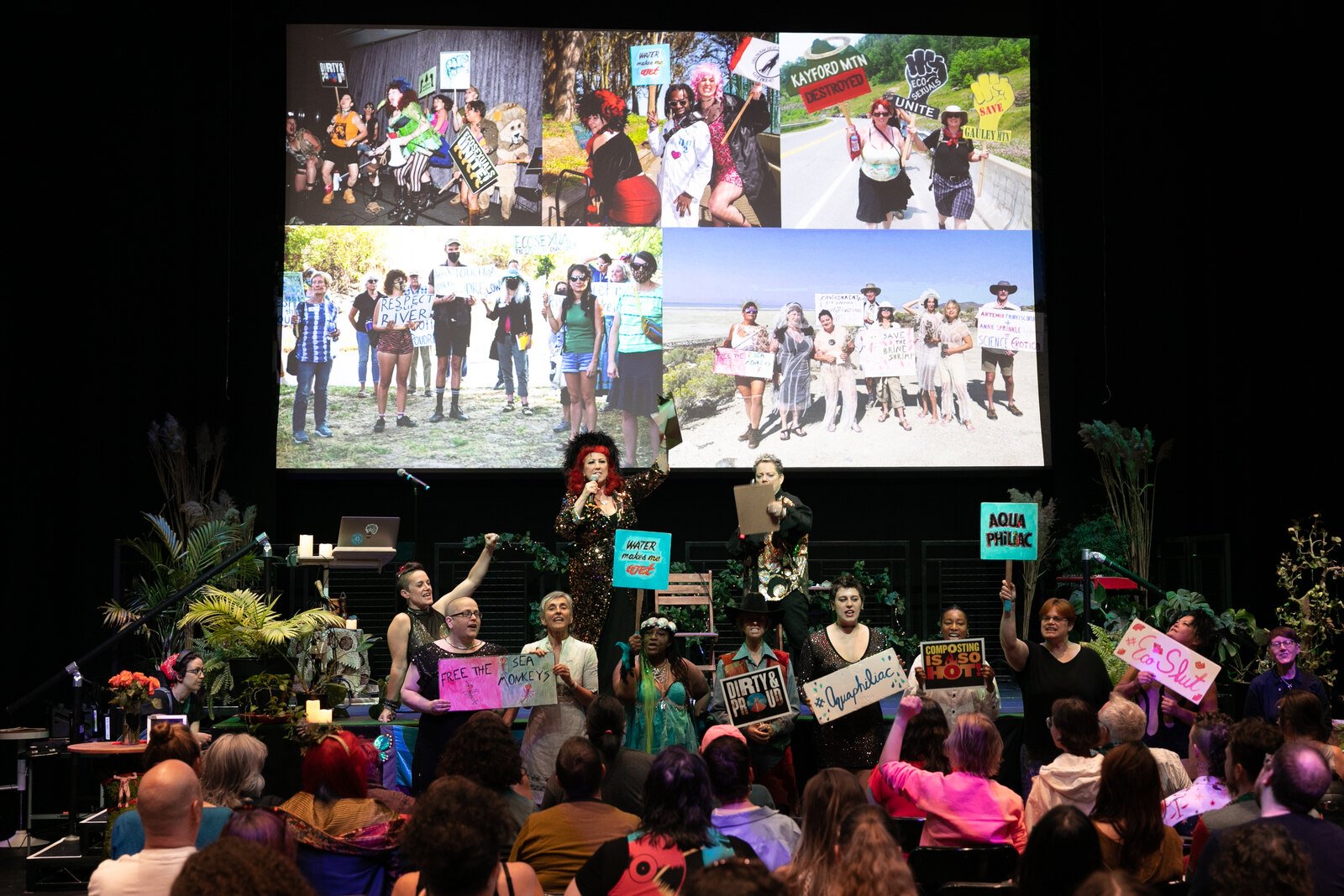
KZ: These movements and gestures – shifting from Mother to Lover Earth, your hydrosex clinics, your ecosex walking rituals – are deeply entwined with activism and activist practices. Annie and Beth, what is the seed of this movement for you, how does advocacy for the planet relate to advocacy for the body?
BS: I grew up in West Virginia, which is coal mining country – very patriarchal, white, and poor. West Virginia is an extraction colony within the US because it is so rich in natural resources. It is also so rural that very few people notice or care when corporations take whatever they want and leave a trail of devastation in their wake. It is a tough place – a place where many people die of diseases caused by pollution generated by extractive processes. There is a saying that I first heard from a West Virginia environmental hero named Larry Gibson, who was a fierce, anti-mountaintop removal (which is a devastating form of strip mining for coal) activist that goes, “what you do to the land, you do to your body.” I have also heard that this saying was originally from Chief Seattle in Washington state. Whomever it came from, both Annie and I relate strongly to it. We believe that our bodies are the Earth. We were both already feminist, freedom of expression and sex-positive activist-artists when we met, but learning about mountaintop removal in West Virginia, and while I was the chair of the Art Department at UC Santa Cruz, I hired the Harrisons, a couple who were important environmental artists in the US. Annie and I also married the Earth in 2008. These things together inspired me to make the film, Goodbye Gauley Mountain: an Ecosexual Love Story (which is also included in the show at Lokal_30). Making this film involved spending a lot of time learning about mountaintop removal mining in West Virginia. These experiences sealed our commitment to loving the Earth through our art practice.
AS: For me personally, the ecosex movement is about expanding notions of sexuality and helping to make people’s lives more pleasurable. Ecosex offers options for more sensual pleasure, for connecting erotically with something more than only genitally-focused sex. For me, ecosex is very much a sex education project. My motto is “eroticise everything.” As we receive pleasure we make the world a more pleasure-filled place. Pleasure and joy can lead to a more happy society. We also care a lot about animals, trees, plants, the health of the soil and air… and all the non-human realms of the planet. If we can help ease some human suffering, that’s really great. And we do!
KZ: And what is your influence in their work as a director, Joy, and also as a collaborator or friend – can I assume that?
JBF: Friend for sure! I respect them so much. It’s such a lateral way of being together. Between the three of us, we have so many ideas and usually so little time, so my job is to help us make creative decisions quickly. I was trained as a director, so I have 20 years of experience in thinking about how we integrate sound and lights, and what the first thing and the last thing that the audience sees. I’m sometimes bringing some very basic theater building blocks to the performance art that they’re creating. And I love an ensemble. I’m an ensemble dork. I directed musical theater back in the day, I did a lot of experimental movement-based theater where the ensemble is this element of design. So often I’m working with the ensemble to figure out how they can come to life and engage with the audience. Annie and Beth will do their thing and we’ll try to swarm around them.
Recently, Annie and Beth have been really into highlighting our collaborative artists. Even these weddings that they’ve hosted mostly were other people performing, and Annie and Beth sitting and being sort of sacred witnesses, you know, the way that sometimes a couple does at a wedding reception, when other people dance or entertain them. So they have always liked to sort of highlight whoever they’re working with. That’s a big part of my job, too, to make sure that our local performers really get to shine…and also so that Annie and Beth can go home and take a nap! You know, they want to make sure each person has good sound and that the theatricality of it is functioning, but they don’t have enough time to sit there and go through things with production assistants. So they can go nap while I do that part. And I love it. I’ve met so many cool people and I’m really grateful to have had this long relationship with them.
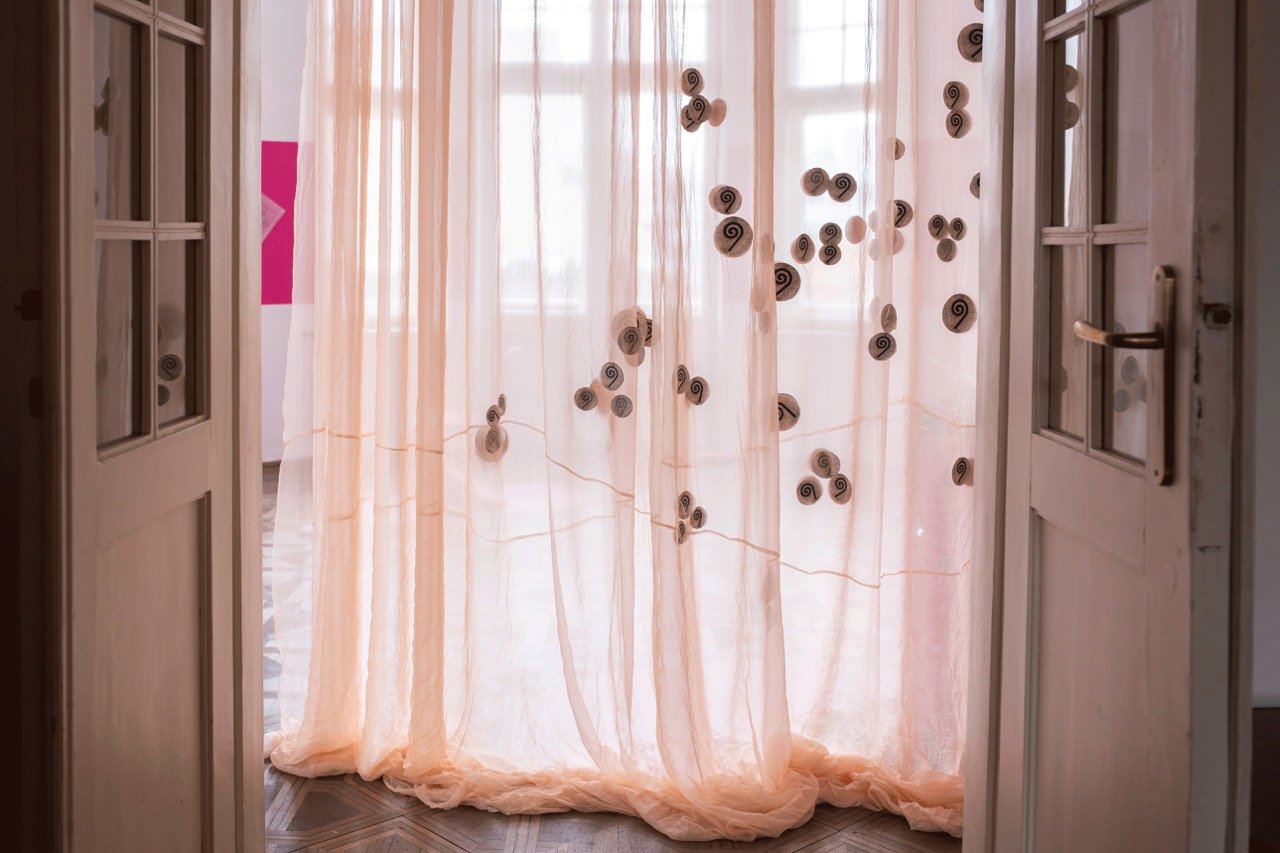
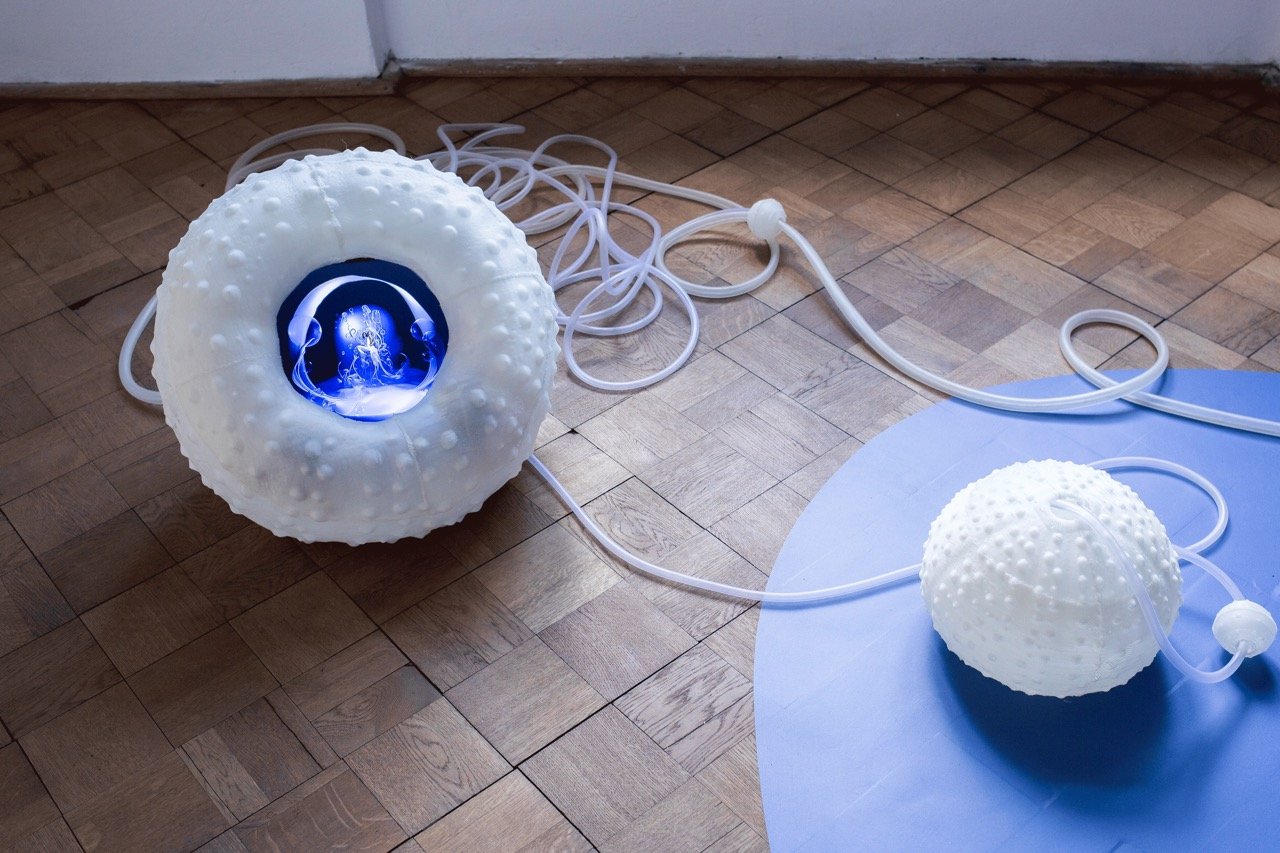
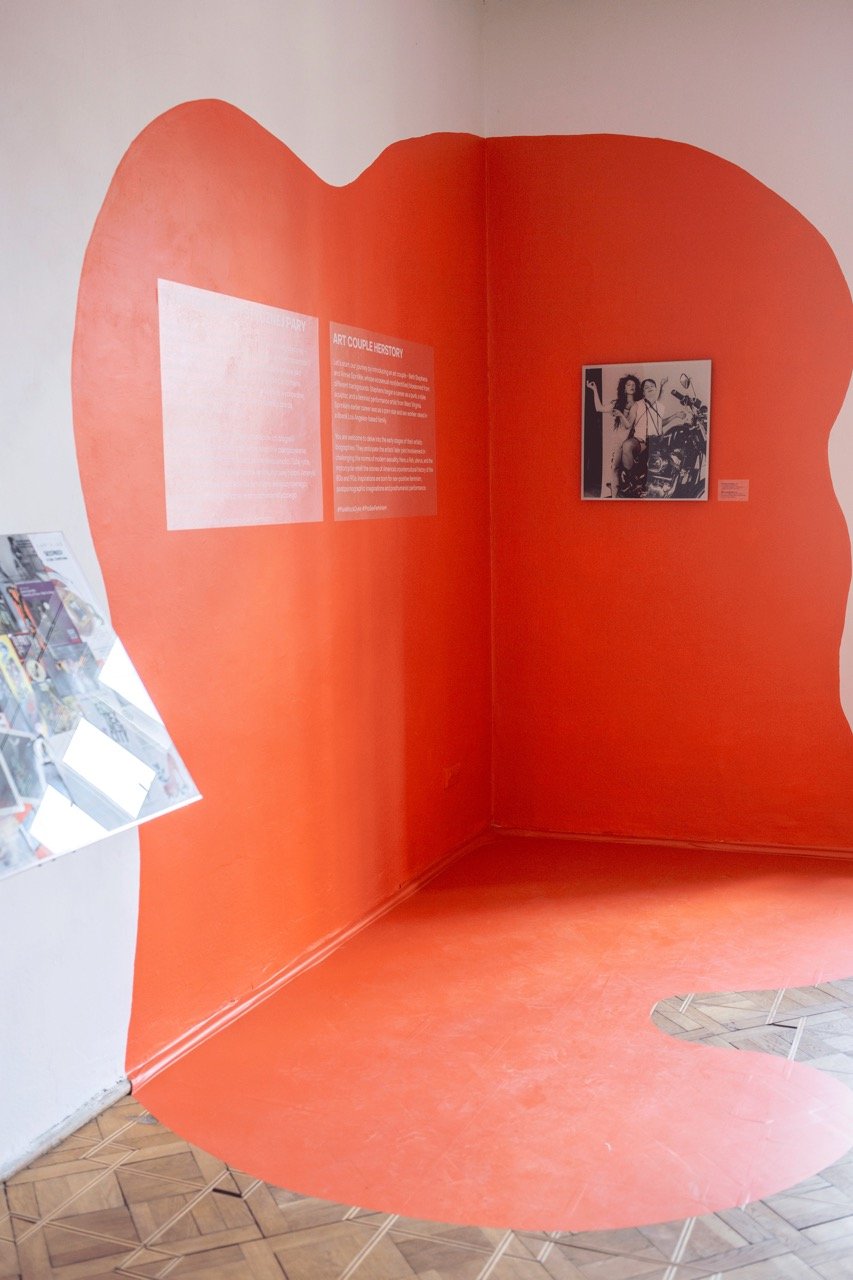
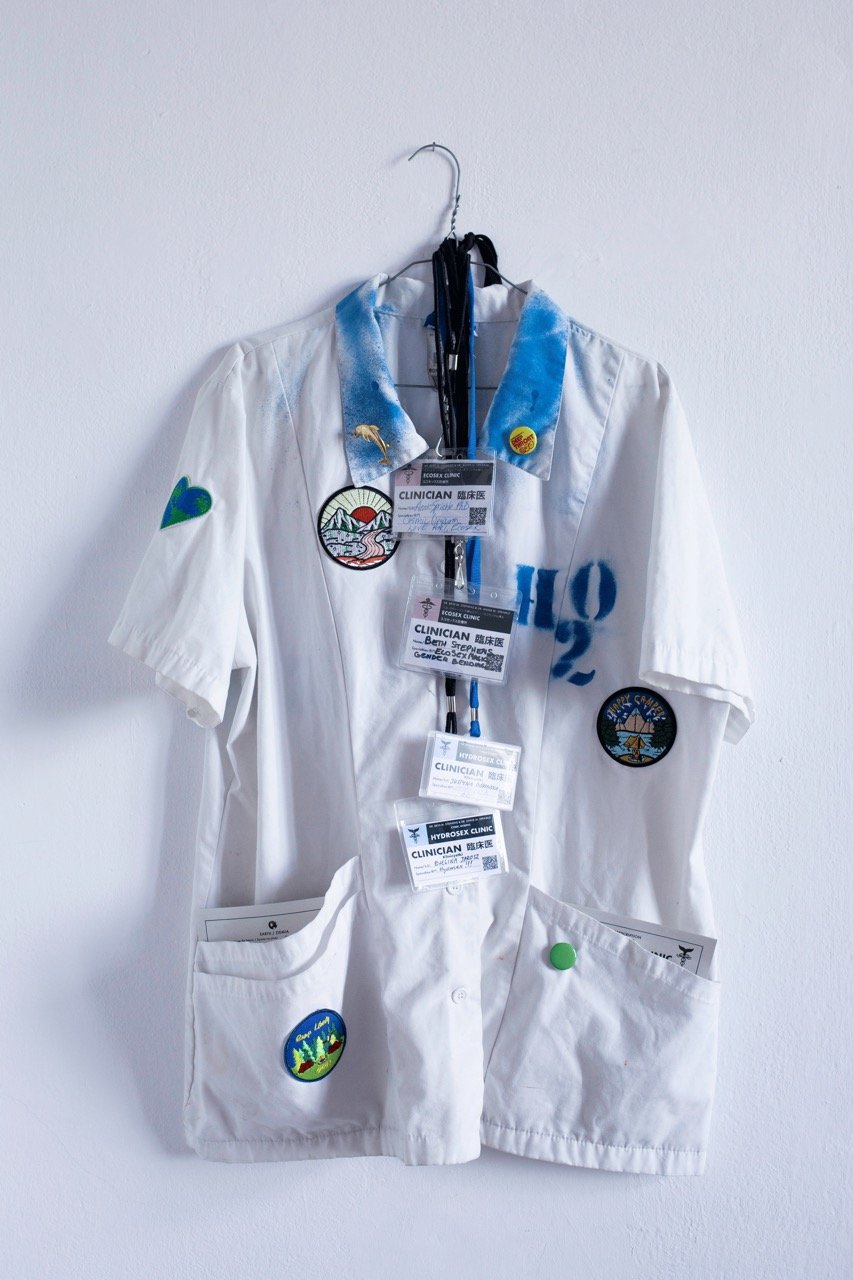
KZ: Annie, last night during the public conversation at Lokal_30 you said that “agony and ecstasy can co-exist.” I think in this part of the world (Central/Eastern Europe), this is something that is occurring very visibly at the moment: people experiencing joyful moments while entrenched in war. So much of your work is so outwardly focused on the idea of love and joy… and love is deeply related to pleasure, but it is also linked with deep pain. How does this duality function in you, in your work?
AS: Good question! Beth’s father used to say, “you can wake up and have a good day, or a bad day. It’s up to you.” Many of us have the luxury and privilege of enjoying simple things. Even in the hospital, or in jail, or struggling with money, we can choose with our minds, with mindfulness, to imagine the Earth as our lover, to feel loved, and to give love… to focus on sensual pleasures. Of course none of what we are doing is new. We’re just reframing and repackaging what many cultures have done in the past.
I have learned that consciously breathing pleasure into the body is a great way to process the hard stuff; we can breathe pleasure to have a good cry, or let a scream come out, or to even feel our numbness and confusion…We can feel all our feelings while bathing them in sexual or sensual energy. The Dalai Lama teaches a simple technique to breathe in peace and relaxation and then exhale any stuff you don’t want. Many cultures have these kinds of techniques. Ecosex is a mindfulness practice, it can be a useful technique and a coping strategy. It’s not for everyone, no way. But if you resonate with the concept of the Earth as lover, it can be a great way to navigate the hard stuff. Ecstasy is just a few breaths away. Just say yes to feeling ecstasy. And you will. From memory. The body remembers how to feel good. You just have to poke it.
BS: We recognize the pain in the world, not only here in Europe but also in the United States – and really everywhere. We also acknowledge the pain that the United States has caused both internally and externally, internationally and domestically. Contemporary life is full of pain, and it is easy to check out through social media, drugs, overeating, drinking, etc. What we hope our work does is that by recognizing the pain of the world and deciding to perform and embrace love and pleasure as something that can empower anyone both in itself, as well as in the community – that we model its availability. We not only embrace pleasure for ourselves, but for those who cannot or will not embrace it, to celebrate life/communities/non-humans/beyond-humans and so on. We embrace pleasure in order to make life easier when it is not. I don’t see the pleasure pain relationship as a duality, but rather as a continuum. One cannot exist without the other. In a capitalistic society, love and pleasure are marketed and sold to make a profit instead of being presented as an available source of energy and healing. We are trying to change that paradigm because everyone and everything deserves love and pleasure, it is free for the giving and the taking. One just has to know it in order to access it. So hopefully, we are making that more known.
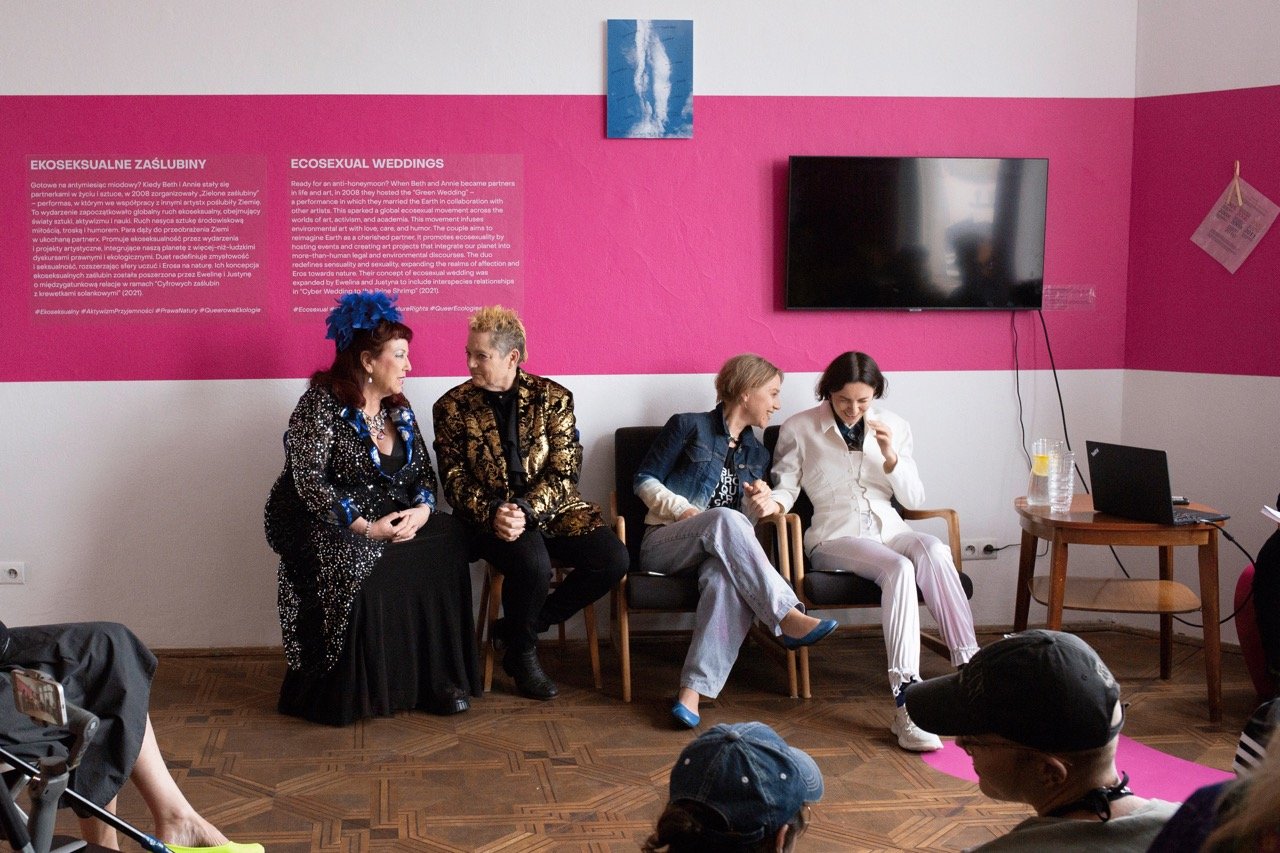
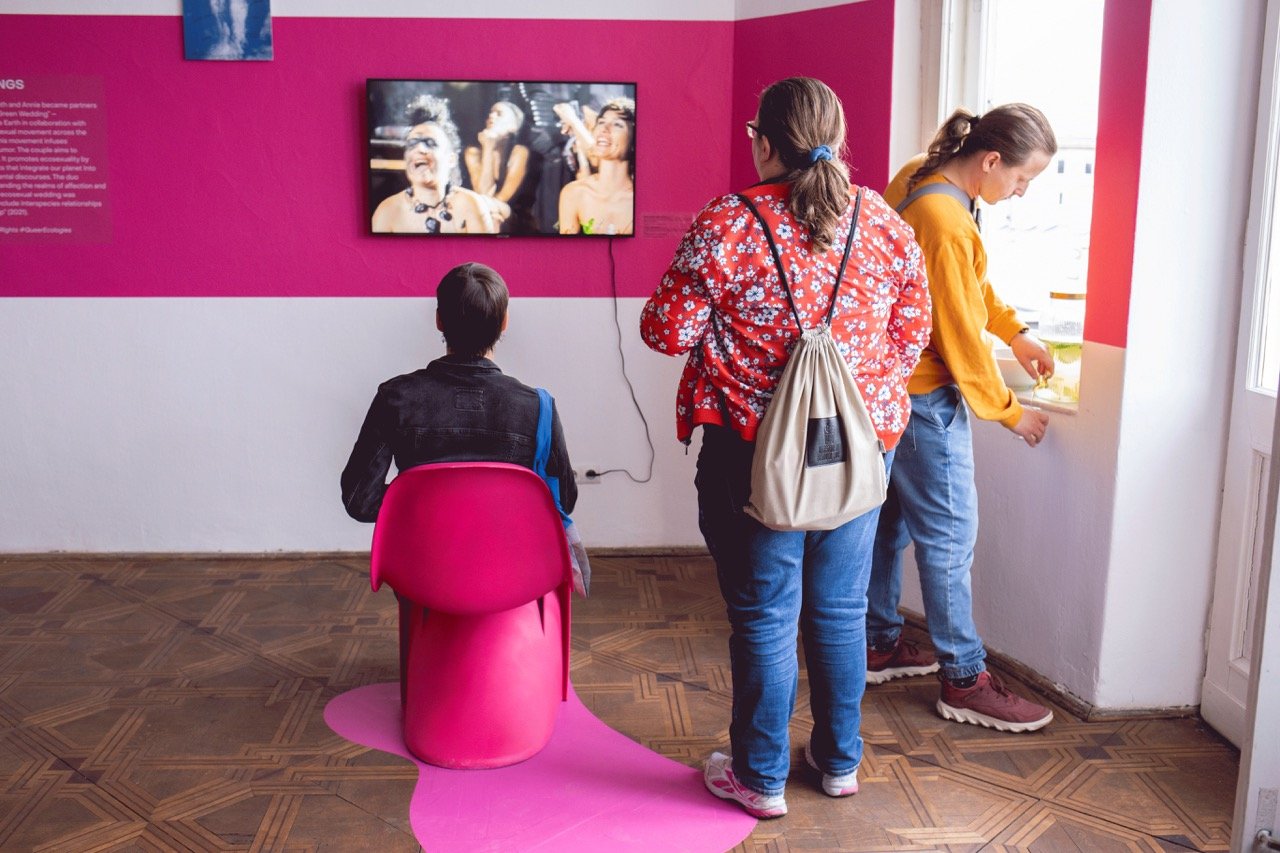
Artist(s): Annie Sprinkle, Beth Stephens; cyber_nymfs: Justyna Górowska, Ewelina Jarosz
Exhibition Title: SPLASH: eco + hydrosexuals unite! | Annie Sprinkle, Beth Stephens, Justyna Górowska, Ewelina Jarosz
Link: https://lokal30.pl/splash-eco-hydrosexuals-unite-annie-sprinkle-beth-stephens-justyna-gorowska-ewelina-jarosz-2/
Venue: lokal_30
Place (Country/Location): Warsaw, Poland
Dates: 15.06. – 14.09.2024
Photos by: exhibition documentation by Matylda Uszyńska.
